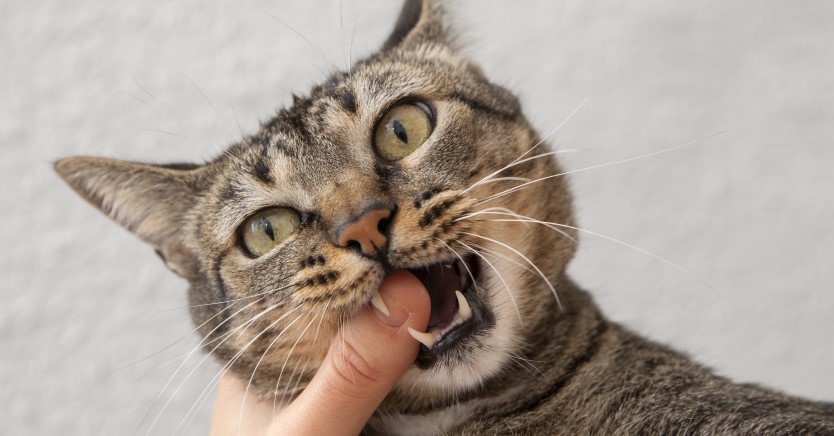Ask Dr. Jenn: Do I Need to Be Worried About Cat Scratch Fever?
I was at a friend’s house this morning and tried to play with her cat. I startled the cat and scared him. He swatted at me, scratched my arm, and bit my thumb. My friend told me to call my doctor right away. Is that really necessary? It was just a couple of small scratches and one little puncture wound. They barely even bled.

“Cat Scratch Fever” is not just an annoying old rock song by Ted Nugent. It is a serious medical condition caused by the bacteria Bartonella henselae. An estimated 30% of cats carry this bacteria in their bodies, but most infected cats rarely show any signs of disease. Any cat can be a carrier of this bacteria in their saliva and can infect you through an open wound. It is most commonly transmitted through a bite or scratch, but a cat licking an open wound can also spread the bacteria.
Signs of cat scratch fever develop between three and fourteen days after a bite or scratch. Worsening pain and swelling around the wound and an enlarged lymph node near the site of the wound are the most common symptoms. Infected apeople may also develop a low-grade fever, headache, and generalized muscle aches. In rare cases, more serious conditions such as encephalitis (inflammation of the brain) or endocarditis (inflammation of the heart) may develop. Many cases of cat scratch fever are self-limiting, meaning the body fights off the bacteria on its own. However, antibiotics may be necessary. Young children and immunocompromised individuals are more likely to become seriously ill with Cat Scratch Fever.
If you have a healthy and mature immune system and develop a cat scratch, rinse the site with warm water for a minimum of five minutes then cover with a bandage. Monitor the site regularly for swelling or pain and call your doctor if you notice enlarged lymph nodes and flu-like symptoms. Your doctor may culture the wound to see if it is cat scratch fever or may prescribe an appropriate antibiotic.
Although cat scratch fever is a concern with any cat scratch, a far more serious concern is a cat bite. Not every cat carries Bartonella henselae, the bacteria that causes cat scratch fever, but all cats have harmful bacteria in their mouth. The cat’s canine teeth, or fangs, can cause small but deep penetrating wounds. Bacteria from the cat’s mouth enter the wound through the bite. Because the wound is small, it closes quickly, trapping bacteria under the skin where they multiply rapidly. Pasteurella multocida is a very pathogenic bacteria commonly found in cats’ mouths and can rapidly cause severe disease. Within twenty-four to forty-eight hours, the bacteria can spread to the surrounding tissue causing cellulitis, or can spread into the blood and cause septicemia. Both are very serious conditions that can lead to loss of tissue, severe illness, and if left untreated, even death.
Almost every person working in the veterinary industry can tell you a story about the dangers of cat bites. We have heard of stubborn doctors who didn’t start antibiotics right away and almost lost their arm due to a rapidly spreading infection. We have heard the stories of veterinary nurses who tried to treat the wounds themselves, only to find a week later they needed surgery to open and flush the wounds to prevent further damage to surrounding nerves and tendons.
I have my own cat-bite horror story. Earlier this winter, a very sweet kitty decided he was tired of me touching him. Without any warning, he chomped on my arm four times. I knew the dangers of a cat bite and I went to the doctor immediately. I was started on an appropriate antibiotic, but my arm continued to swell. After two days, I was feeling nauseous, weak, feverish, and could barely use my arm. I spent three days in the hospital getting intravenous antibiotics to kill all the bacteria in my arm. After about two weeks of recovery time, I am happy to say that the only lasting effects are the scars on my arm and the huge dent in my bank account when the hospital bills started to roll in.
Although illness from cat scratch fever is mostly limited to humans, a cat bite can also cause a serious infection in other animals. About five days after a cat has been in a fight, it presents to the vet with painful, swollen tissue around the bite. They often have a high fever and may have an abscess – a large swelling filled with pus at the site of the bite.
You may think your bite is not a big deal. Your family may be obnoxious like mine and sing:
They give me Cat Scratch Fever
Cat Scratch Fever
I got it bad scratch fever
Cat Scratch Fever
And hum some rock guitar licks (please YouTube the video if you are too young to know what I’m talking about).
In summary, your friend is right. Cat bites should always be taken seriously, no matter how small the wound. You should flush the puncture wound immediately, cover it with a bandage to protect it, and call your doctor. Early intervention is the best way to avoid serious complications.
Ready to start saving money on pet wellness care?
Then take a look at Mint Wellness, the pet wellness plan that provides fast reimbursement on routine pet care. Save on vaccinations, wellness exams, preventatives, dental, and more!
Learn More


